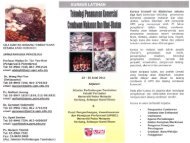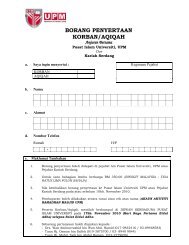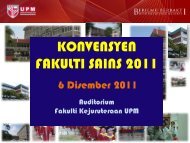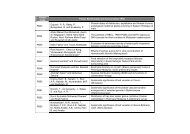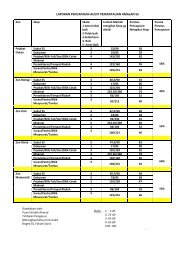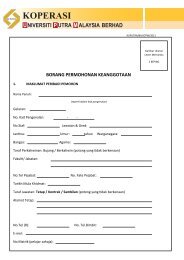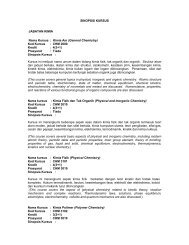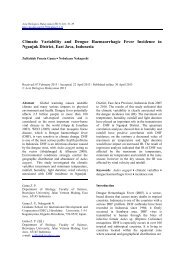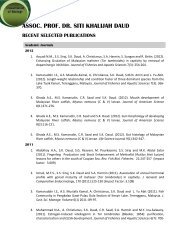Programme Book - UPM - Universiti Putra Malaysia
Programme Book - UPM - Universiti Putra Malaysia
Programme Book - UPM - Universiti Putra Malaysia
You also want an ePaper? Increase the reach of your titles
YUMPU automatically turns print PDFs into web optimized ePapers that Google loves.
P47 REDOX POLYMERISATION OFPOLY(ACRYLONITRILE/ACRYLIC ACID) CO-POLYMERS ANDITS SORPTION BEHAVIOUR TOWARDS Cu(II) AFTERMODIFICATION WITH HYDROXYLAMINE HYDROCHLORIDE.R. Mohamad, S.N.A Md. Jamil*Department of Chemistry, Faculty of Science, <strong>Universiti</strong> <strong>Putra</strong> <strong>Malaysia</strong>, 43400 <strong>UPM</strong>Serdang, Selangor, <strong>Malaysia</strong>Corresponding author: nurul_ainjamil@yahoo.comThe synthesis of poly(acrylonitrile/acrylic acid) copolymers were carried out by redoxpolymerization using sodium bisulfate (SBS) and potassium persulphate (KPS) asfree radical initiators and deionized water as reaction medium.The polymerizationsproceeded with various monomer ratios which are 100:0, 97:3, 95:5 and 93:7respectively to obtain different porous structure. Poly(AN/AA) copolymers weremodified by hydroxylamine hydrochloride for 6 hours. The purpose of modification isto convert cyano group in poly(AN/AA) to amidoxime(AO) which was proven bycomplex-forming properties to adsorb Cu(II).The modified and unmodifiedcopolymers were characterized by Fourier Transform Infrared Spectroscopy(FTIR)and Scanning Electron Microscope(SEM). Inductive Coupled Plasma (ICP) was usedto investigate Cu(II) adsorption properties in modified poly(AN/AA). As shown in theFTIR spectra of modified and unmodified poly(AN/AA), the characteristic band ofnitrile group present in the range of 2244cm -1 and C=O stretching from carboxylgroup of acrylic acid appear in the range of 1600-1700 cm -1 . For the spectra ofamidoximated poly(AN/AA), the strong band at 3600-3400 cm -1 were assigned to OHstretching.The band at 1665 cm -1 was observed due to the formation of new C=Nfuctional groups in modified poly(AN/AA) indicating the successful of surfacemodification. According to the SEM analysis, the averange particle size of themodified poly(AN/AA) is bigger as compared to the particle size of the unmodifiedpoly(AN/AA). Hence, it is proven that the surface morphology of the modifiedpoly(AN/AA) copolymers provide high porous structure,thus,enhancing adsorption ofCu(II) from aqueous solution. The adsorption properties of modified poly(AN/AA)was investigated at different parameters which are the effect of dosage amount,contact time, initial concentration and optimum experimental conditions. A maximumCu(II) removal by modified poly(AN/AA) occurred at pH 5 with 52.70 mg/g at25°C. The maximum contact time required for adsorption was 4 hours. Sorptioncapacity was also directly proportional to initial concentration of 25 ppm to 400 ppmat pH 5. Dosage amount decrease the sorption capacity from 22.67 mg/g to 4.75mg/g. The Langmuir model was much better than the Freundlich model to describethe isothermal process. The Cu(II) adsorption is more efficient by using modifiedpoly(AN/AA) copolymers at the optimum conditions.62 |16 th Industrial Chemistry Seminar: Chemistry- A Passport to a Brighter Future




